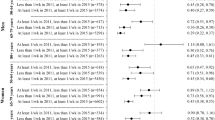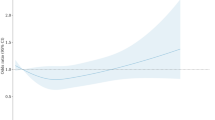Abstract
Background
Associations between levels of sedentary behavior and depressive symptoms independently and in combination with different levels of physical activity remain unclear.
Purpose
This study aimed to examine independent and combined associations of physical activity (PA) and sedentary behavior (SB) with depressive symptoms among Japanese adults.
Method
An Internet-based survey collected data on depression levels (Center for Epidemiologic Studies Depression Scale), self-reported time spent in PA and SB (Japanese short version of the International Physical Activity Questionnaire), and sociodemographic variables from 2,914 adults in 2009. Binary logistic regression analyses were conducted to examine the odds ratios (ORs) for being depressed (depression scores ≥16) according to independent PA levels (none, insufficient, sufficient), SB levels (low, moderate, high), and nine combinations of PA and SB categories.
Results
After adjusting for potential confounders, sufficient PA level was found to be related to lower risk of depressive symptoms independently (OR = 0.61), whereas no significant associations were observed between SB levels and depression. In the combined associations, adults in the sufficient PA/high SB (OR = 0.44), sufficient PA/moderate SB (OR = 0.56), and sufficient PA/low SB (OR = 0.57) categories were significantly less likely to have depressive symptoms in comparison with the no PA/high SB category.
Conclusion
Meeting physical activity recommendations is associated with a lower risk of depressive symptoms, regardless of time spent in total sedentary behavior. These results suggest that promoting physical activity may be an effective strategy against depressive symptoms among Japanese adults.

Similar content being viewed by others
References
Cassano P, Fava M. Depression and public health: an overview. J Psychosom Res. 2002;53:849–57.
Chapman DP, Perry GS, Strine TW. The vital link between chronic disease and depressive disorders. Prev Chronic Dis. 2005;2:A14.
Kawakami N. Epidemiology of depressive disorders in Japan and the world. Nihon Rinsho. 2007;65(9):1578–84 (in Japanese).
Dunn AL, Trivedi MH, O’Neal HA. Physical activity dose-response effects on outcomes of depression and anxiety. Med Sci Sports Exerc. 2001;33:S587–97.
Teychenne M, Ball K, Salmon J. Physical activity and likelihood of depression in adults: a review. Prev Med. 2008;46:397–411.
Paluska SA, Schwenk TL. Physical activity and mental health: current concepts. Sports Med. 2000;29:167–80.
De Wit L, van Straten A, Lamers F, Cuijpers P, Penninx B. Are sedentary television watching and computer use behaviors associated with anxiety and depressive disorders? Psychiatry Res. 2011;186:239–43.
Primack BA, Swanier B, Georgiopoulos AM, Land SR, Fine MJ. Association between media use in adolescence and depression in young adulthood: a longitudinal study. Arch Gen Psychiatry. 2009;66:181–8.
Teychenne M, Ball K, Salmon J. Sedentary behavior and depression among adults: a review. Int J Behav Med. 2010;17:246–54.
Bauman A, Ainsworth BE, Sallis JF, Hagströmer M, Craig CL, Bull FC, et al. The descriptive epidemiology of sitting. A 20-country comparison using the International Physical Activity Questionnaire (IPAQ). Am J Prev Med. 2011;41(2):228–35.
Inoue S, Sugiyama T, Takamiya T, Oka K, Owen N, Shimomitsu T. Television viewing time is associated with overweight/obesity among older adults, independent of meeting physical activity and health guidelines. J Epidemiol. 2012;22:50–6.
Liao Y, Harada K, Shibata A, Ishii K, Oka K, Nakamura Y, et al. Joint associations of physical activity and screen time with overweight among Japanese adults. Int J Behav Nutr Phys Act. 2011;8:131.
Sugiyama T, Healy GN, Dunstan DW, Salmon J, Owen N. Joint associations of multiple leisure-time sedentary behaviours and physical activity with obesity in Australian adults. Int J Behav Nutr Phys Act. 2008;1:35.
Kolappa K, Henderson DC, Kishore SP. No physical health without mental health: lessons unlearned? Bull World Health Organ. 2013;91(1):3–3A.
Ishii K, Shibata A, Oka K. Association between recommended levels of physical activity and depressive symptoms among Japanese adults: a cross-sectional study. Mental Health Phys Act. 2011;4:57–63.
Ministry of Health, Labour and Welfare of Japan. (2005). The national health and nutrition survey 2005. Tokyo. Retrieved 01.02.15 from. http://www.mhlw.go.jp/bunya/kenkou/eiyou07/01.html (in Japanese).
Ministry of Internal Affairs and Communications of Japan. (2007). Employment status survey 2007. Retrieved 01.02.15 from. http://www.e-stat.go.jp/SG1/estat/List.do?bid¼000001013824&cycode¼0 (in Japanese).
Shima S, Shikano T, Kitamura T, Asai M. New self-rating scales for depression. Seishin-Igaku. 1985;27:717–23 (in Japanese).
IPAQ website, IPAQ scoring protocol. https://sites.google.com/site/theipaq/scoring-protocol (accessed Dec 12 2014)
Haskell WL, Lee IM, Pate RR, Powell KE, Blair SN, Franklin BA, et al. Physical activity and public health: updated recommendation for adults from the American College of Sports Medicine and the American Heart Association. Med Sci Sports Exerc. 2007;39:1423–34.
Patel AV, Bernstein L, Deka A, Feigelson HS, Campbell PT, Gapstur SM, et al. Leisure time spent sitting in relation to total mortality in a prospective cohort of US adults. Am J Epidemiol. 2010;172(4):419–29.
Murase N, Katsumura T, Ueda C, Inoue S, Shimomitsu T. International standardization of physical activity level: reliability and validity study of the Japanese version of the International Physical Activity Questionnaire (IPAQ) (Kosei no Shihyo). J Health Welf Stat. 2003;49:1–9 (in Japanese).
Van Uffelen JG, van Gellecum YR, Burton NW, Peeters G, Heesch KC, Brown WJ. Sitting-time, physical activity, and depressive symptoms in mid-aged women. Am J Prev Med. 2013;45(3):276–81.
Stamatakis E, Davis M, Stathi A, Hamer M. Associations between multiple indicators of objectively-measured and self-reported sedentary behaviour and cardiometabolic risk in older adults. Prev Med. 2012;54(1):82–7.
Atkin AJ, Adams E, Bull FC, Biddle SJ. Non-occupational sitting and mental well-being in employed adults. Ann Behav Med. 2012;43(2):181–8.
Davies CA, Vandelanotte C, Duncan MJ, van Uffelen JG. Associations of physical activity and screen-time on health related quality of life in adults. Prev Med. 2012;55(1):46–9.
Carr LJ, Commentary on Atkin et al. (2011): non-occupational sitting and mental well-being in employed adults. Ann Behav Med. 2012;43(2):149-50.
Hallal PC, Gomez LF, Parra DC, Lobelo F, Mosquera J, Florindo AA, et al. Lessons learned after 10 years of IPAQ use in Brazil and Colombia. J Phys Act Health. 2010;7:S259–64.
Rzewnicki R, Vanden Auweele Y, De Bourdeaudhuij I. Addressing overreporting on the International Physical Activity Questionnaire (IPAQ) telephone survey with a population sample. Public Health Nutr. 2003;6:299–305.
Wijndaele K, DE Bourdeaudhuij I, Godino JG, Lynch BM, Griffin SJ, Westgate K, et al. Reliability and validity of a domain-specific last 7-d sedentary time questionnaire. Med Sci Sports Exerc. 2014;46(6):1248–60.
Eysenbach G, Wyatt J. Using the Internet for surveys and health research. J Med Internet Res. 2002;4(2):E13.
Rhodes SD, Bowie DA, Hergenrather KC. Collecting behavioural data using the world wide web: considerations for researchers. J Epidemiol Community Health. 2003;57:68–73.
Shibata A, Oka K, Harada K, Nakamura Y, Muraoka I. Psychological, social, and environmental factors to meeting physical activity recommendations among Japanese adults. Int J Behav Nutr Phys Act. 2009;28:60.
Vandelanotte C, Sugiyama T, Gardiner P, Owen N. Associations of leisure-time internet and computer use with overweight and obesity, physical activity and sedentary behaviors: cross-sectional study. J Med Internet Res. 2009;11(3):e28.
Acknowledgments
This study was supported by the Grant-in-Aid for Scientific Research (No. 26242070) from Japan Society for the Promotion of Science and the 29th Research Grant in Medical and Health Science of Meiji Yasuda Life Foundation of Health and Welfare.
Conflict of Interest Statement
Yung Liao, Ai Shibata, Kaori Ishii, and Koichiro Oka declare that they have no conflict of interest.
Author information
Authors and Affiliations
Corresponding author
Rights and permissions
About this article
Cite this article
Liao, Y., Shibata, A., Ishii, K. et al. Independent and Combined Associations of Physical Activity and Sedentary Behavior with Depressive Symptoms Among Japanese Adults. Int.J. Behav. Med. 23, 402–409 (2016). https://doi.org/10.1007/s12529-015-9484-0
Published:
Issue Date:
DOI: https://doi.org/10.1007/s12529-015-9484-0




